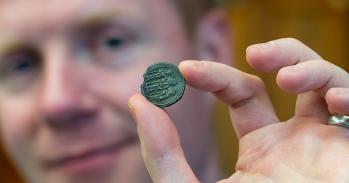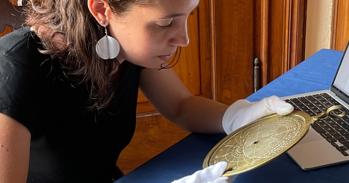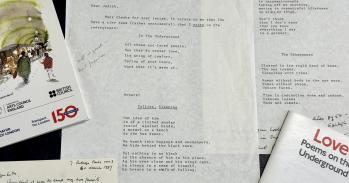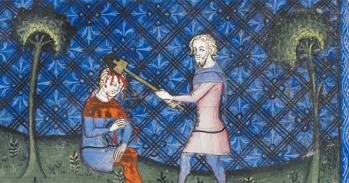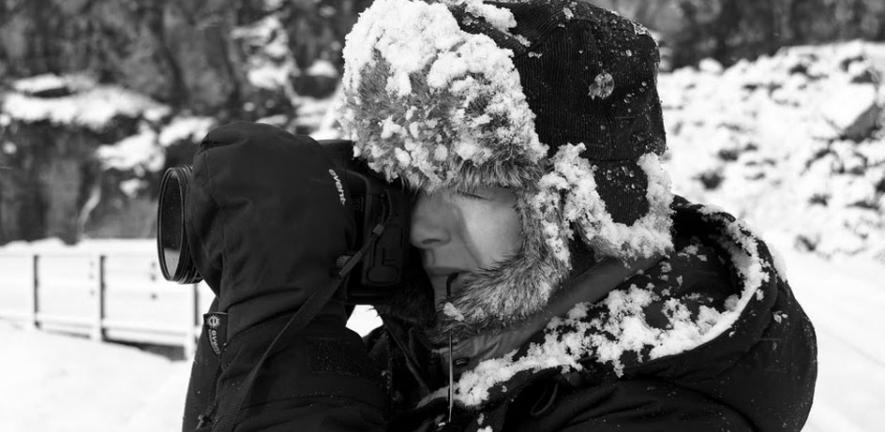
Now mid-way through a year-long 21st-century pilgrimage to the settings of Iceland’s famous medieval Íslendingasögur (‘sagas of Icelanders’), Dr Emily Lethbridge has crisscrossed the country in her ex-MOD Land Rover ambulance on the trail of outlaws, shapeshifters, mound-dwelling viking-zombies, and ordinary men and women who lived in Iceland a thousand years ago.
Now mid-way through a year-long 21st-century pilgrimage to the settings of Iceland’s famous medieval Íslendingasögur (‘sagas of Icelanders’), Dr Emily Lethbridge has crisscrossed the country in her ex-MOD Land Rover ambulance on the trail of outlaws, shapeshifters, mound-dwelling viking-zombies, and ordinary men and women who lived in Iceland a thousand years ago.
I can milk a herd of 50 cows on my own and at times I am happiest with shovel in hand and a good half-an-hour’s worth of early morning cow-pat clearing-up to get stuck into..."
Emily Lethbridge
Written in the 13th and 14th centuries, the Íslendingasögur are an extraordinary literary genre that transmit stories about the individuals who lived, loved, fought and died in the 9th, 10th and 11th centuries after the island had been settled by them. To this day, the sagas are a cornerstone of Icelandic culture.
Researcher Dr Emily Lethbridge’s quest to travel around Iceland reading each of the 30 sagas in the very landscapes, the ‘saga-steads’, in which they were set began in January 2011. The decommissioned ‘Embulance’ is her mobile home for the duration of the research project.
One objective of her partly sponsored and partly self-funded trip, which can be followed at http://sagasteads.blogspot.com/, is to gather material on Icelandic culture for her research in the Department of Anglo- Saxon, Norse and Celtic.
“This kind of ‘literary fieldwork’ approach is not only strengthening and making my understanding of the sagas more nuanced, both as narratives in themselves and as a medieval and modern cultural phenomenon, but also I hope that the book I’m writing about the sagas and the ways in which they are inscribed in the spectacular Icelandic landscape will appeal to a general audience as well as a specialist one.”
What would others be surprised to learn about you?
I can milk a herd of 50 cows on my own and at times I am happiest with shovel in hand and a good half-an-hour’s worth of early morning cow-pat clearing-up to get stuck into... I learnt how to speak modern Icelandic by spending the summer of 2008 on a farm in the north of Iceland, during the first year of my Research Fellowship at Emmanuel College. The family on the farm taught me modern phrases and pronunciation (my Old Icelandic vocabulary prompted equal amounts of laughter and bewilderment); the cows taught me to be more patient.
Who or what inspires you?
The magnificence and power of the Icelandic landscape, in all different weathers and at all times of year. I consider myself exceptionally lucky to have this opportunity to explore the endlessly varying terrain across the country in such depth. Travelling and living in the ambulance in the winter months did present certain physical challenges at times, but the northern lights, the perfection of deep unblemished snow on the mountains and in the valleys, and the feeling of exhilaration when storms were raging outside but I was safe and warm in the ambulance will be what I remember. Now it’s warmer, I only have to look out of the window in the back of the ambulance to want to get out there to work.
Have you ever had a Eureka moment?
Realising, as a graduate student, that there is no definitive text of any single saga was a very exciting moment. The sagas were copied continuously in Iceland from the medieval period right up until the 19th century, and even into the early 20th century. They are anonymously authored and each time someone copied a saga from one manuscript they were free to alter the text however they liked, to improve the style or content, for example. The manuscripts bear witness to centuries of human engagement with, and enjoyment of, the sagas. Suddenly, the sagas became more to me than compelling stories printed between the covers of editions lined up on library shelves. The idea that the concept of an ‘original text’ is irrelevant as far as the sagas are concerned, and also that no single manuscript-text of a saga need be considered the ‘best’ text, was an extremely liberating one that opened up all kinds of new possibilities for me as far as my research into the sagas, and their transmission and reception, was concerned.
What’s the best piece of advice you’ve ever been given?
My grandfather used to say ‘Let the saw do the work’ when teaching me and my brother and sister wood-working as children; I can hear him intoning the phrase as though I’m listening to a recording. My carpentry skills never really evolved beyond making various crude constructions that parents seemed to value as presents, but I have come to think that it’s not a bad precept to try to live and work by – to utilise the energy, ideas and resources one has already in order to try to move forward and make progress.
If you could wake up tomorrow with a new skill, what would it be?
Waking up with a professional understanding of exactly what’s going on under the bonnet of my Land Rover (as well as the Icelandic words for every part of the engine) would be very useful... I am learning on the job, so to speak, and have various manuals to hand (this makes people I’ve met here who know about cars laugh!). But it’s another world in there and I wouldn’t say I’m a natural mechanic...
What is your favourite research tool?
This year: my two feet, walking boots and a 31-part set of 1:100,000 maps of Iceland.
This work is licensed under a Creative Commons Licence. If you use this content on your site please link back to this page.


